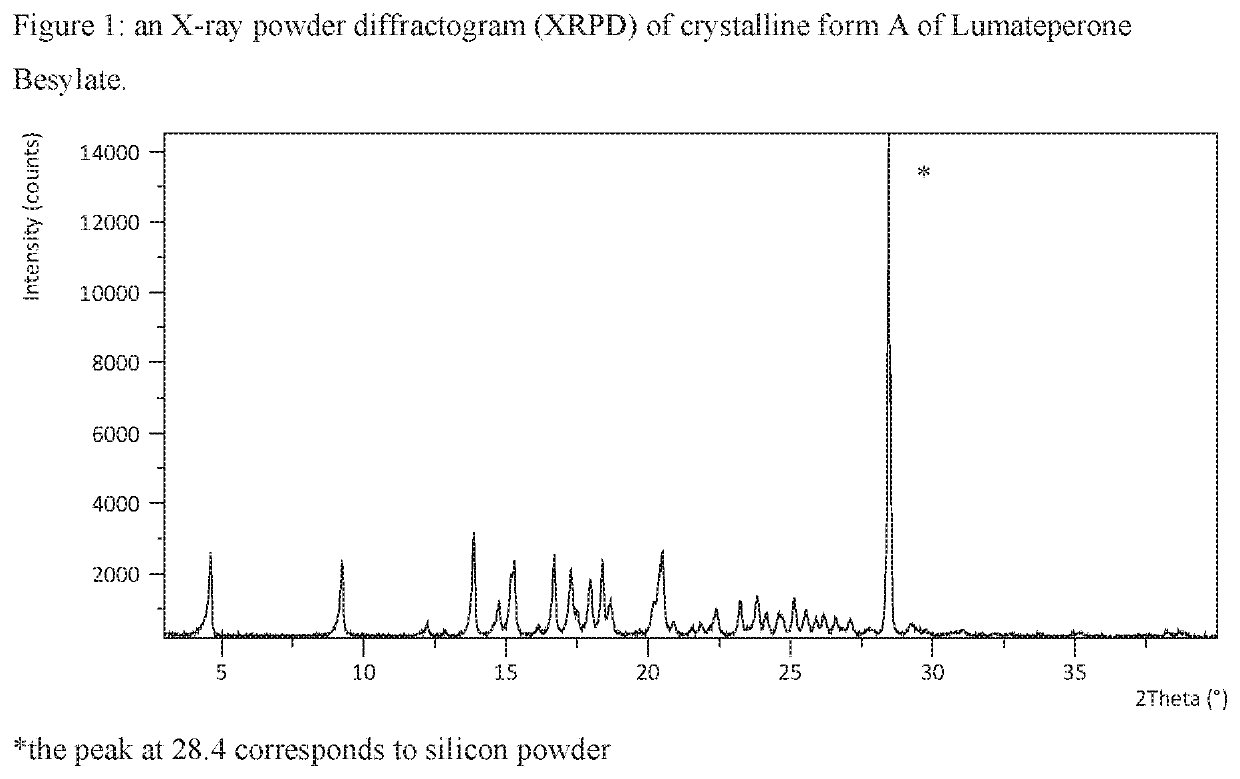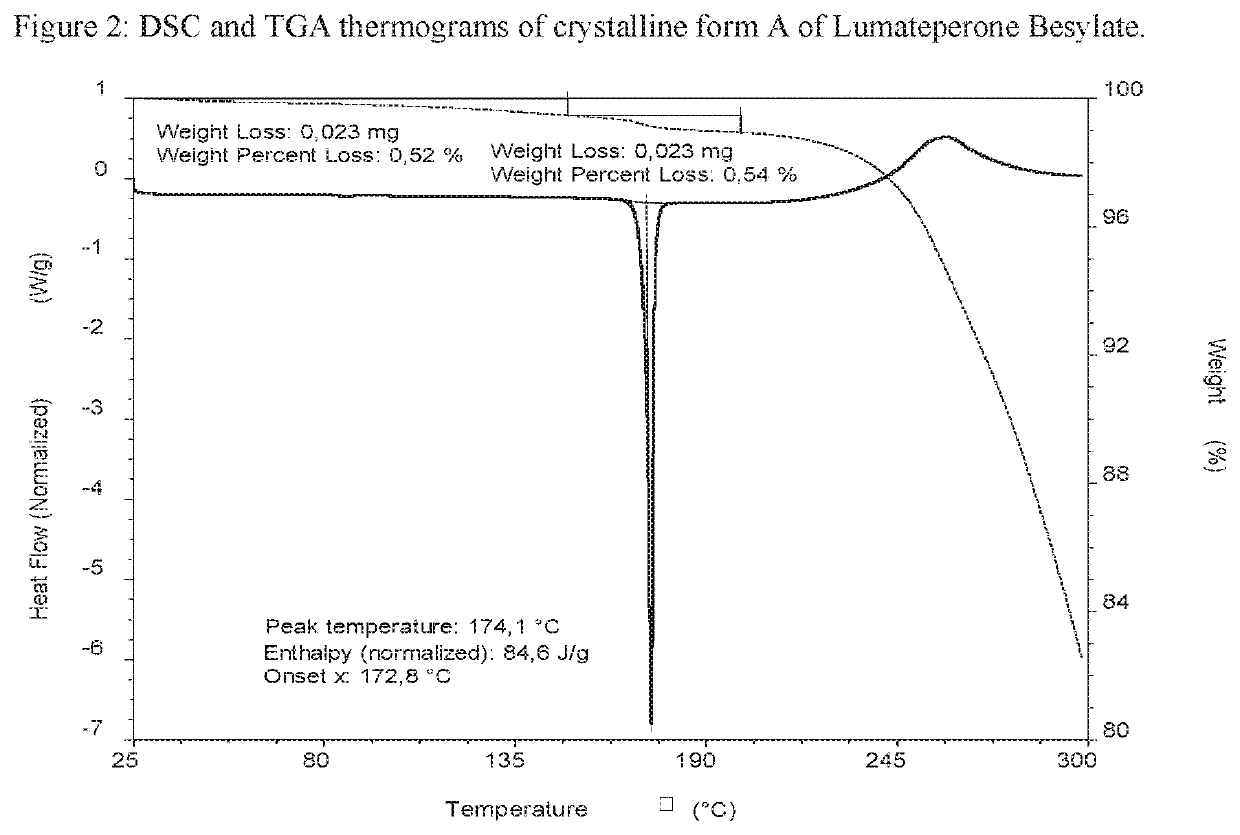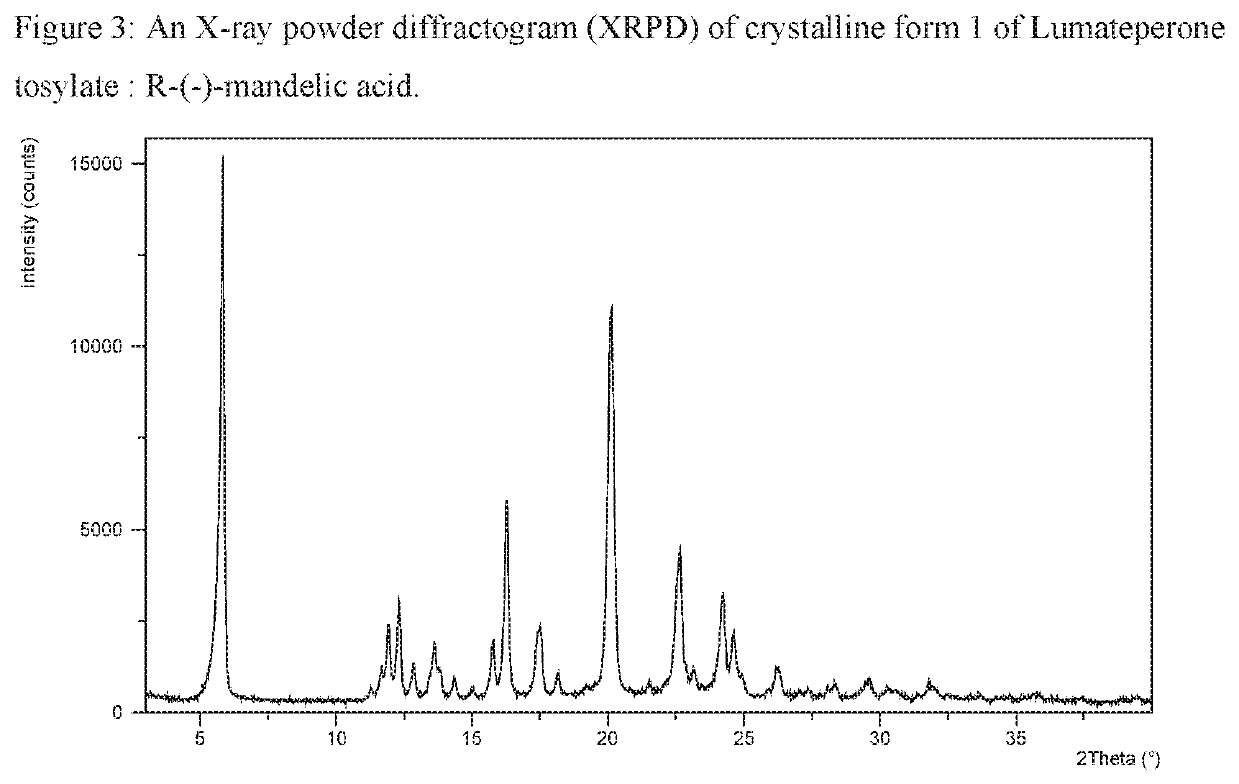Solid state forms of lumateperone salts and processes for preparation of lumateperone and salts thereof
a technology of lumateperone and lumateperone salt, which is applied in the field of solid state forms of lumateperone besylate, can solve the problems of difficult salt of the compound, poor stability, and hygroscopicity
- Summary
- Abstract
- Description
- Claims
- Application Information
AI Technical Summary
Benefits of technology
Problems solved by technology
Method used
Image
Examples
example 1
on of Form A of Lumateperone Besylate
Procedure A
[0370]Lumateperone base (0.50 g; 1.27 mmol) was dissolved in acetone (0.8 mL) at about 50° C. Benzenesulfonic acid (0.25 g; 1.60 mmol; 1.3 eq) was dissolved in acetone / IPA 4:1 (2 mL) at room temperature and added drop wise to the base solution at about 50° C. The reaction mixture was stirred at about 50° C. for 30 minutes, cooled, under stirring, over 40 minutes to room temperature and stirred for 1 hour, then further cooled, under stirring, over 120 minutes to about 5° C. and stirred for 30 minutes. The precipitate was filtered and washed with acetone (0.5 mL). The obtained solid was analysed by XRPD, DSC and TGA. The XRPD pattern is presented in FIG. 1 and the DSC and TGA thermograms are presented in FIG. 2.
example 2
on of Crystalline Form 1 of Lumateperone Tosylate:R-(−)-Mandelic Acid
Procedure A
[0371]Lumateperone tosylate (1.0 gram) was dissolved in acetone (50 mL) and evaporated by rotary evaporator at 20 mbar and 50° C. Obtained amorphous form of Lumateperone tosylate (0.025 grams; 0.044 mmol) and R-(−)-Mandelic acid (0.007 grams; 0.046 mmol) were suspended in toluene (0.2 mL) at RT (25° C.). Suspension was stirred during 2 days at RT (25° C.). Suspension was filtered and analysed by XRPD and the XRPD pattern is presented in FIG. 3.
Procedure B
[0372]Lumateperone tosylate Form A (0.05 g; 0.088 mmol) and R-(−)-Mandelic acid (0.013 g; 0.085 mmol) were subjected to ball mill milling by agate ball mill (2 agate balls p=7 mm, frequency: 25 Hz, time: 60 min) with the addition of toluene (0.1 mL). Obtained solid was analysed by XRPD and identified as form 1.
example 3
on of 6-Bromo-2,3,4,5-Tetrahydro-1H-Pyrido[4,3-b]Indole Hydrochloride (IVa)
[0373]
[0374](2-Bromophenyl)hydrazine hydrochloride (100 grams; 447 mmol; 1 molEq), piperidin-4-one hydrochloride (73 grams; 538.39 mmol; 1.2 molEq) and ethanol (700 mL) were charged in 1 L reactor. Concentrated hydrochloric acid (100 mL; 1184 mmol; 2.65 molEq) was added dropwise. Resulting suspension was heated to reflux overnight. Reaction mixture was cooled down to 0° C. and stirred 2 hours. Product was filtered off, washed with cold ethanol (5×100 ml) and dried in vacuo. Crude 6-bromo-2,3,4,5-tetrahydro-1H-pyrido[4,3-b]indole hydrochloride was isolated as light brown solid in 76% yield (116.37 grams; 83.66% assay; 96.86 Area % UPLC purity). m / z=251 (positive).
PUM
| Property | Measurement | Unit |
|---|---|---|
| chemical shift | aaaaa | aaaaa |
| temperature | aaaaa | aaaaa |
| temperature | aaaaa | aaaaa |
Abstract
Description
Claims
Application Information
 Login to View More
Login to View More - R&D
- Intellectual Property
- Life Sciences
- Materials
- Tech Scout
- Unparalleled Data Quality
- Higher Quality Content
- 60% Fewer Hallucinations
Browse by: Latest US Patents, China's latest patents, Technical Efficacy Thesaurus, Application Domain, Technology Topic, Popular Technical Reports.
© 2025 PatSnap. All rights reserved.Legal|Privacy policy|Modern Slavery Act Transparency Statement|Sitemap|About US| Contact US: help@patsnap.com



